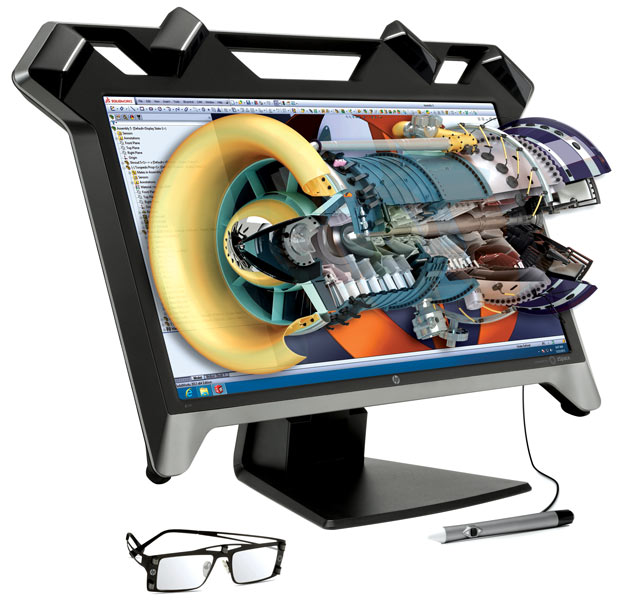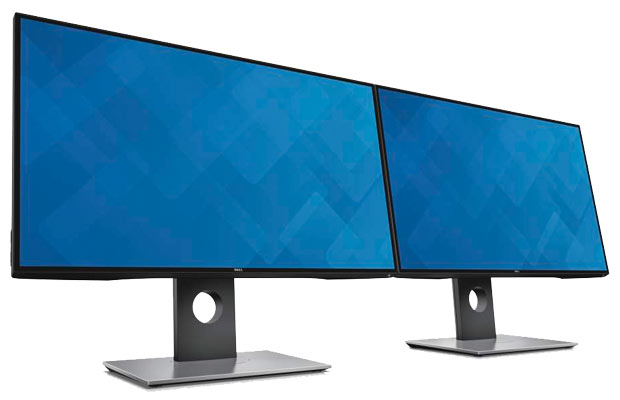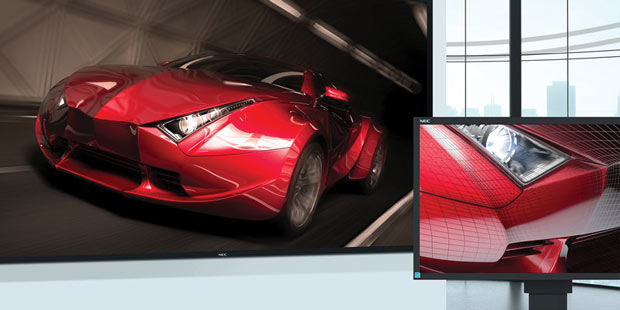A Closer Look at Displays

The HP Zvr display, part of the company’s approach to “blended reality” within the design process. Image courtesy of HP.
Latest News
May 2, 2016
 The HP Zvr display, part of the company’s approach to “blended reality” within the design process. Image courtesy of HP.
The HP Zvr display, part of the company’s approach to “blended reality” within the design process. Image courtesy of HP.Designers on the market for a new workstation spend a lot of time making sure they’ve got the right graphics cards, the right applications and enough computing horsepower to do their work as efficiently as possible. One sometimes overlooked element of the workstation, however, is the display panel. Display technology is rapidly evolving, however, and it is increasingly important to make sure the monitor is matched correctly to the workstation, the applications, and the type of work the user is doing. Not doing so can lead to frustrating latency issues, as well as clarity and even ergonomic problems.
There are three basic types of display panels available: twisted nematic (TN), vertical alignment (VA), and in-plane switching (IPS). TN panels are the oldest and most commonly available, but for designers, the experts DE spoke to recommend IPS monitors, which typically offer better color reproduction and better viewing angles.
Beyond monitor type, there are a number of other key considerations to take into account when selecting a new display.
Resolution. When it comes to resolution (the number of distinct pixels that can be displayed in each dimension), higher is generally better when it comes to design work. The higher the pixel density, the more detail you can see on the screen.
“To do detailed work on CAD files and in other application, you need to understand what level of detail you need to be able to drill into,” says Michael Turner, product manager at Dell.
For many users, that has meant Quad HD (or 2K) resolution, but the general trend is now toward 4K ultra high definition (UHD) displays. Both your applications and your workstation hardware have to be able to support that resolution in order to see any benefit, however. “Be aware that if you are using a graphics card that is a few yeas old, it probably can’t drive the 4K displays,” says Art Marshall, product manager at NEC.
“For design, you want to go with more resolution and a larger display,” says Rodrigo Mancilla, product manager at Lenovo. “You can improve your work by being able to look at the full project instead of having to constantly navigate across the design.”
There are also 5K displays, but they haven’t gained much market traction because there isn’t as much noticeable difference between 4K and 5K displays. The next big shift upward in resolution will likely come in the form of 8K displays—although the benefit of that upgrade is more apparent with larger-than-desktop displays.
Size. How big a panel you can use is more often dictated by available space, but larger displays allow you to see more of your work with less scrolling. “A 27-in. display is not that much larger than a 24-in. display physically, but it does make a difference in CAD applications,” says Greg Staten, chief architect, Professional Display Business at HP. “That bit of acreage gives you better resolving detail when looking at a model.”
Aspect ratios (the width and height) are largely standardized at 16:9 (or in some cases, 16:10), but there are some other options emerging that designers should keep an eye on. “We’re now seeing a trend toward 21:9 ultra-wide panels, but there are not a lot of applications that can support that yet,” says Jenny Lai, product manager at BenQ North America.
Size also affects the number of monitors on a designer’s desk. Dual monitors are increasingly common (in some set-ups, design applications are displayed on one unit, while other applications are relegated to others). If you want additional monitors, then having a graphics adapter with multiple outputs is becoming standard in the industry,” Mancilla says. “We see a day not too far away when users will go from dual monitors to quad monitors.”
Thin-bezel designs are also making it easier to align two or even three monitors side by side for a multi-display arrangement that allows you to view a full image across all screens.
Ergonomics. Size also has an effect on ergonomic considerations. The monitor should be a reasonable distance from your eyes, and offer enough tilt and rotation so that it can be effectively adjusted. The brightness of the panel should be equivalent to the lux in the environment to reduce eye fatigue. If the display is brighter than the ambient environment, it can cause eyestrain.
“Having the ability to do a proper tilt and proper size adjustment is a big deal, and one of the mistakes people make is putting their displays up too high,” Staten says. “The display should be just below eye level, so you are looking down at the display rather than straight ahead or up.”
Color Accuracy and Contrast Ratio. As noted before, IPS panels have greater color accuracy and better viewing angles. “IPS panels give you the best overall contrast ratio and color reproduction,” Marshall says. “If you are looking at simulations and stresses, being able to see color accurately is very important.”
Larger displays with good off-axis performance are critical for collaboration as well, because more viewers gathered around a display can see an accurate representation of the picture.
“If the contrast ratio is not good, you can’t see crisp details, and it would be harder to manage your work,” says Lai. “In the design field, you need color-accurate monitors.”
This has become more important over time. HP now offers its Dreamcolor displays with factory calibration and better color accuracy out of the box. Dell offers color-critical (10-bit) and non-color-critical (8-bit) monitors, with a roughly $200 difference between them. “If you don’t need the color-critical performance, you could purchase a product that delivers comparable performance for less,” Turner says.
Connectivity. How you connect the monitor to the workstation and other peripherals also affects performance. Most manufacturers have standardized on DisplayPort (which has replaced VGA, DVI and other standards). There are some users that require HDMI. Other emerging possibilities include USB Type-C and Thunderbolt.
Critically, you have to have enough throughput from the workstation to the display to support the resolution of the monitor. “You have to have the connectivity to get the right resolution,” Dell’s Turner says. “Just because you have DisplayPort doesn’t mean you can support 4K at 60Hz. Understanding the throughputs on the connections is important. If you have a 4K display and get a 30Hz refresh [rate], that latency is going to be discouraging.”
Thunderbolt and USB Type-C allow for data and video via the same connector, but these options are more expensive than HDMI and DisplayPort, and there aren’t yet many video cards that support USB Type-C.
Eventually, most monitors will have USB 3.0 ports on them so users can connect high-speed peripherals directly to the monitor. Thunderbolt makes it possible for a monitor to serve as a hub for multiple devices, including high-performance storage. How you plan to use the hardware will drive decisions about connection technology.
“Investigate how you are going to set things up beforehand,” Turner says. “If you need PCI pass through to run a large external storage drive, then you have to be equipped for that. Understand the docking scenario or connectivity scenario before investing in USB Type-C or Thunderbolt.”
Application Support. This is another evolving consideration. While more people are buying 4K resolution displays, not all software can support that resolution. In particular, text and icons might be difficult to view on older Windows systems because of scaling issues.
“Windows 10 has helped with those applications that have been updated for high pixel density displays,” HP’s Staten says. “If they have not been updated, then the icons are very small, which makes some tools difficult to use. Text can also look very fuzzy and indistinct, which contributes to eye fatigue. You need to have a proper scaling engine.”
Important Trends
Over the next few years, vendors anticipate continued demand for larger displays and higher resolution, including more interest in UHD displays, larger display size and higher resolution. There is increasing demand for 4K UHD screens and high-dynamic-range (HDR) imaging displays.
HDR panels provide incredible levels of detail and much better blacks and whites. However, the displays are more expensive.
 Dell’s UltraSharp U2717D has InfinityEdge bezels for super-thin bezel design. Image courtesy of Dell.
Dell’s UltraSharp U2717D has InfinityEdge bezels for super-thin bezel design. Image courtesy of Dell.“I think HDR is going to start being adopted more in the video production and photography area rather than design,” Marshall says. “But in five years we may see more mainstream models coming out with that option.”
“HDR can give you a very high contrast ratio, and they are good for media and entertainment where you want to be able to show a wide dynamic range that a digital camera can capture,” Staten says. “The challenge I see in an office is wrapping your brains around what the user needs to see. We know that a bright image is fatiguing. It could be useful for fly-throughs or presentations to customers.”
Another emerging technology that likely won’t have much impact on the market for another few years is OLED (organic light emitting diode). Most current panels use liquid crystal display (LCD) technology. OLED doesn’t require a backlight to function, and can provide power savings as well as much higher refresh rates (up to 1KHz) and vivid contrast and black levels.
However, OLEDs are more difficult to manufacture and present a few other challenges. According to Marshall at NEC, OLEDs present color reproduction and fidelity challenges over time because the OLEDs burn out more quickly based on the type of content you put on the screen. Very bright or white content can fade the screen faster.
 The current trend for CAD/CAM applications is to use ultra high definition (UHD) displays. Image courtesy of NEC.
The current trend for CAD/CAM applications is to use ultra high definition (UHD) displays. Image courtesy of NEC.“There is a big challenge with differential aging,” Staten adds. “The red, green and blue OLED material decomposes as you push voltage through it, and the crystals do so at different rates. That can’t be color corrected out because it happens on a per-pixel level.”
It could be another two years before OLED displays are available for standard workstations, although Dell has already debuted its first OLED UltraHD panel, the UltraSharp 30 UP3017Q, which will retail for around $5,000. It can display 1.07 billion colors, and is rated at 100% of the AdobeRGB color space, and 97.8% of the DCI-P3 color space.
That focus on contrast and color will likely supplant resolution, which appears to have hit a wall in terms of user requirements. “You can only go so far in terms of density before the human eye cannot perceive the benefit,” Mancilla says. “Going from 4K to 5K, there isn’t much of a difference. 8K is impressive, but you really have to have a large display. If you are using a 24-in. monitor, you probably won’t see much of a difference.”
Also, 5K nor 8K displays are supported with a single display port; you have to have two or four display port inputs.
Better color presentation, on the other hand, has a direct impact on design and simulation work. “We’re seeing a trend toward people adding that dynamic range of image so the human eye can see the differences in the darkest and brightest sections of an image,” Mancilla says. “That is an area that will benefit design.”
More Info
Subscribe to our FREE magazine, FREE email newsletters or both!
Latest News
About the Author
Brian Albright is the editorial director of Digital Engineering. Contact him at [email protected].
Follow DERelated Topics






